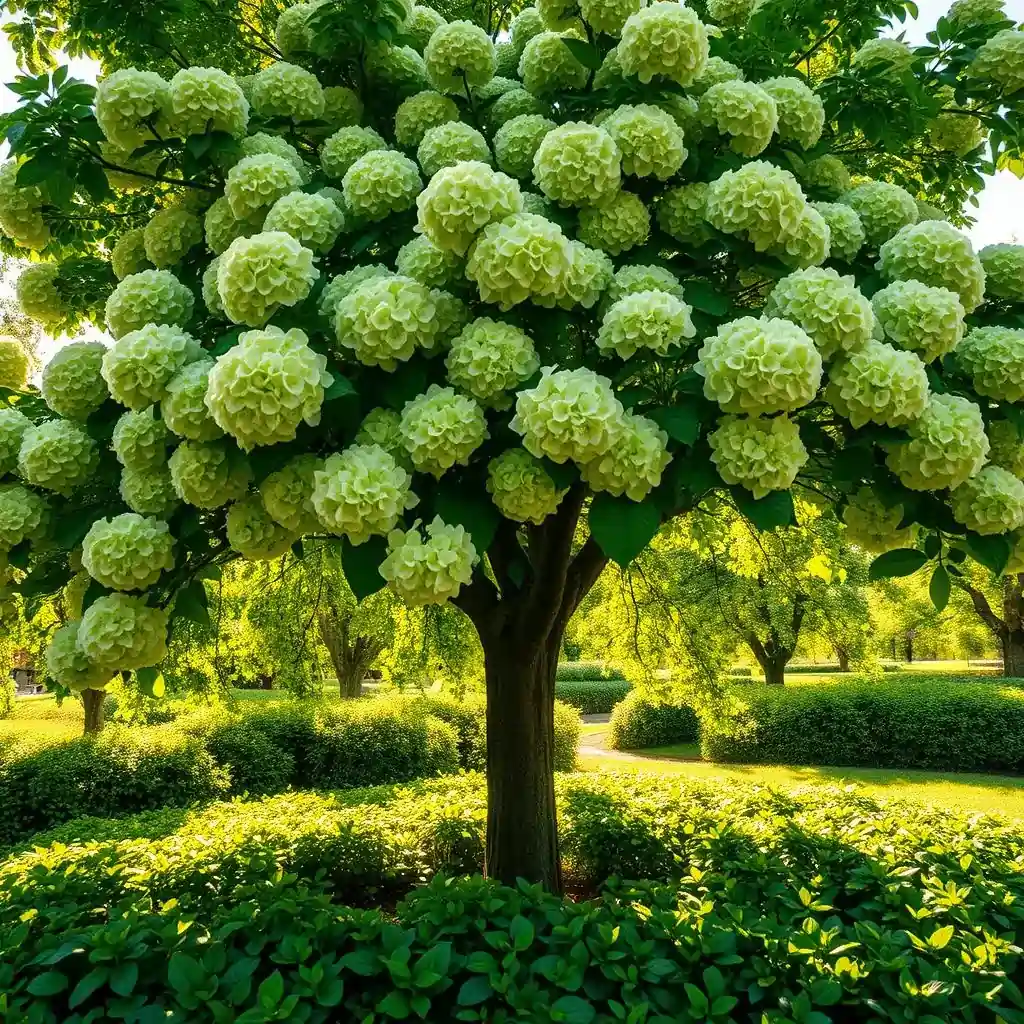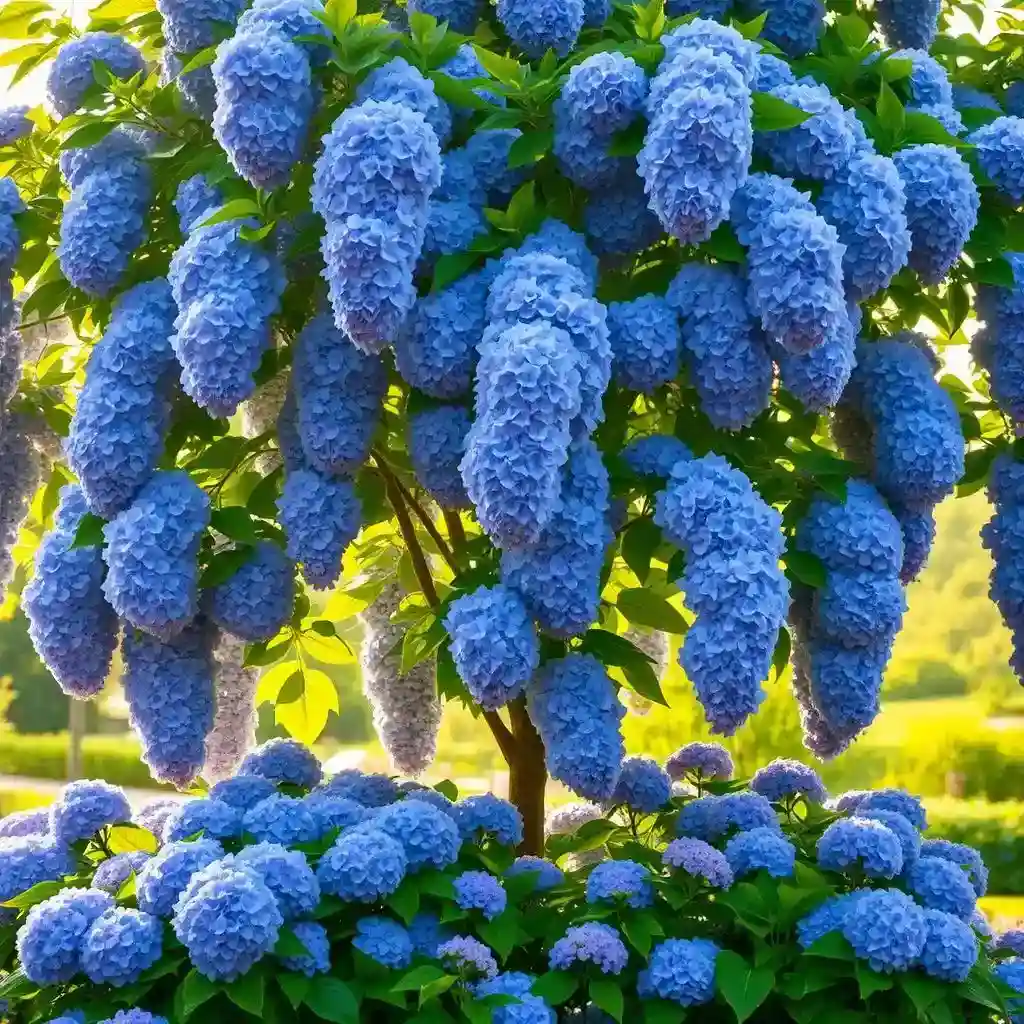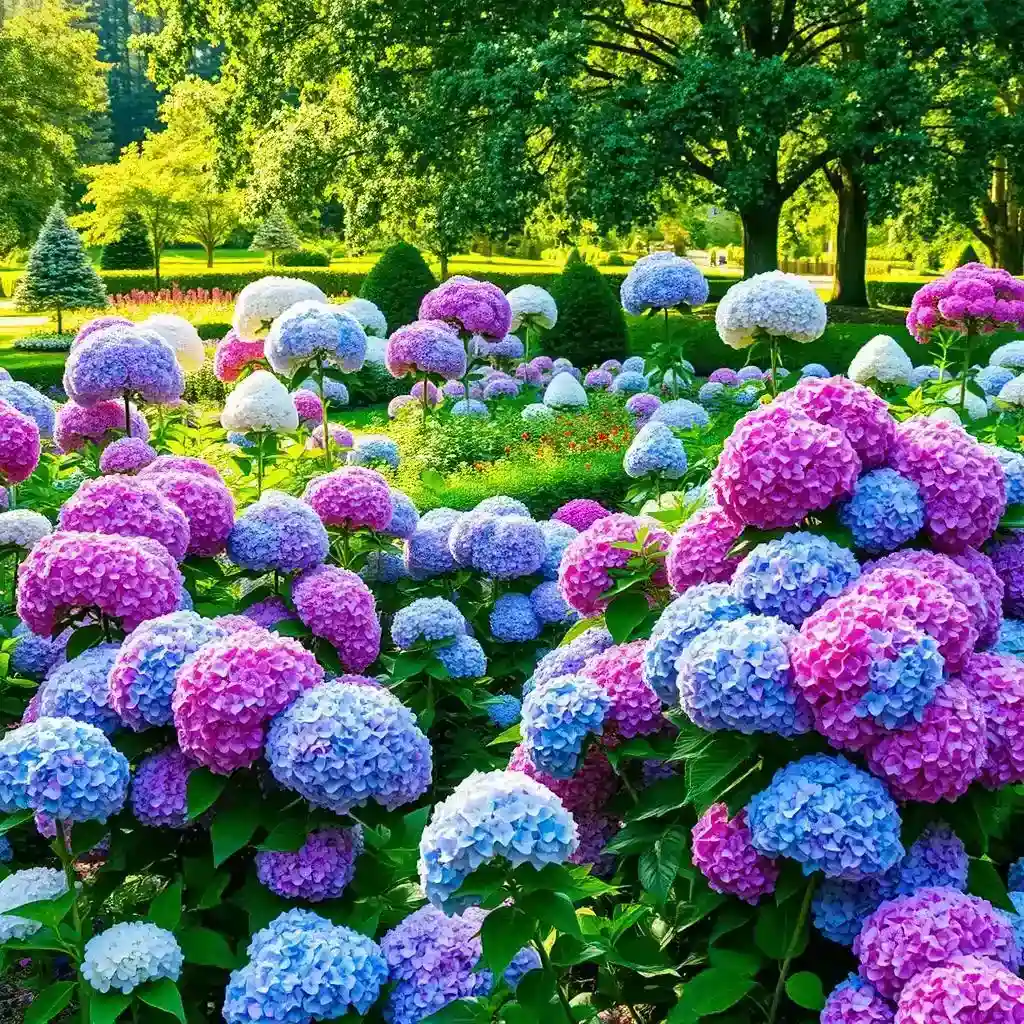Growing a hydrangea tree can be a rewarding experience, adding beauty and elegance to any garden. The limelight hydrangea tree is a popular variety known for its vibrant blooms and relatively low maintenance requirements.
To successfully grow a hydrangea tree, it’s essential to understand its needs, including the right soil conditions, sunlight, and watering schedule. With proper care, these trees can thrive and become a stunning focal point in your landscape.
Key Takeaways
- Choose the right variety of hydrangea tree for your climate.
- Plant in well-draining soil with adequate sunlight.
- Water regularly, but avoid overwatering.
- Fertilize annually to promote healthy growth.
- Prune your hydrangea tree to maintain its shape and encourage blooming.
What Makes Hydrangea Trees Special
Unlike their shrub counterparts, hydrangea trees bring a new level of sophistication to landscape design. They offer a unique combination of beauty, structure, and versatility that makes them a popular choice among gardeners.
Differences Between Hydrangea Shrubs and Trees
One of the primary differences between hydrangea shrubs and trees is their growth habit. Hydrangea trees are trained to grow into a tree-like form, with a single main stem or trunk, whereas shrubs are typically multi-stemmed and more compact. This difference in structure can significantly impact the overall appearance of your garden or landscape.
Benefits of Growing Hydrangea Trees
Growing hydrangea trees can offer several benefits, including:
- Visual Interest: Their tree-like form adds a new layer of visual interest to your garden.
- Versatility: They can be used as a specimen plant or as part of a larger landscape design.
- Long-Lasting Blooms: Many varieties of hydrangea trees produce long-lasting blooms that can be enjoyed throughout the growing season.
Hardiness Zones and Climate Considerations
When selecting a hydrangea tree, it’s essential to consider the hardiness zone and climate in your area. Most hydrangea trees thrive in USDA zones 3-8, but some varieties are more tolerant of extreme temperatures than others. Be sure to choose a variety that is well-suited to your local climate to ensure optimal performance.
The world of hydrangea trees is diverse, with popular varieties like Limelight, Vanilla Strawberry, and Pinky Winky captivating gardeners. These varieties offer a range of characteristics that can enhance any garden.
Limelight Hydrangea Tree
The Limelight Hydrangea Tree is known for its large, lime-green blooms that gradually turn pink as they age. This variety is particularly prized for its ability to thrive in a variety of conditions.
Distinctive Features
Large Blooms: The Limelight Hydrangea Tree produces enormous flowers, often reaching up to 8 inches in diameter.
Color Change: The blooms transition from a vibrant lime green to a soft pink, adding a dynamic element to the garden.
Growing Requirements
This variety prefers well-drained soil and partial shade to full sun, making it versatile for different garden settings.
Vanilla Strawberry Hydrangea Tree
The Vanilla Strawberry Hydrangea Tree is celebrated for its unique, cone-shaped blooms that start white and gradually turn pink, then deep strawberry red.
Unique Characteristics
Cone-Shaped Blooms: The distinctive shape of the flowers sets this variety apart.
Multi-Color Blooms: The color transition from white to strawberry red adds visual interest.
Special Care Tips
To maintain the health and vigor of the Vanilla Strawberry Hydrangea Tree, regular watering and fertilization are recommended.
Pinky Winky Hydrangea Tree
The Pinky Winky Hydrangea Tree is admired for its conical panicles that are initially white and gradually turn pink, creating a striking display.
Bloom Patterns
The flowers appear in mid-summer, providing a beautiful contrast to the green foliage.
Ideal Growing Conditions
This variety thrives in well-drained soil and full sun to partial shade, making it suitable for a range of garden environments.
| Variety | Bloom Color | Growing Conditions |
| Limelight | Lime Green to Pink | Well-drained soil, partial shade to full sun |
| Vanilla Strawberry | White to Pink to Strawberry Red | Well-drained soil, regular watering |
| Pinky Winky | White to Pink | Well-drained soil, full sun to partial shade |
Selecting the Perfect Location for Your Hydrangea Tree

The success of your hydrangea tree depends on selecting a location that meets its specific needs. A well-chosen location will ensure your tree grows healthily and blooms beautifully.
Sunlight Requirements
Hydrangea trees generally prefer partial shade to full sun, depending on the variety. Most can thrive in morning sun and afternoon shade, especially in warmer climates.
Soil Composition and pH
The soil should be rich, fertile, and well-draining. Hydrangea trees prefer a slightly acidic to neutral soil pH (between 6.0 and 7.0). Adjusting the soil pH can be done by adding lime to raise it or sulfur to lower it.
Spacing and Companion Plants
Proper spacing is essential to allow for air circulation and growth. Companion plants like hostas or ferns can complement hydrangea trees by adding texture and shade. A table outlining some companion plants and their benefits is provided below.
| Companion Plant | Benefits |
| Hostas | Shade, texture, and pest control |
| Ferns | Shade, texture, and natural mulch |
| Creeping Thyme | Ground cover, fragrance, and weed suppression |
By considering these factors, you can select a location that will support the health and beauty of your hydrangea tree.
Step-by-Step Hydrangea Tree Planting Guide
The process of planting a hydrangea tree involves several key steps that ensure its success. Whether you’re a seasoned gardener or a beginner, following these steps will help your hydrangea tree thrive.
Best Time to Plant
The best time to plant a hydrangea tree depends on your location. In general, spring or fall are considered ideal times because they offer mild temperatures and ample moisture. Avoid planting during the hottest summer months or when the ground is frozen.
Preparing the Planting Hole
To prepare the planting hole, dig a hole that is twice as wide and just as deep as the root ball of your hydrangea tree. If your soil is poorly draining, consider raising the bed by 6-8 inches to improve drainage. Mix in organic matter like compost to enhance soil fertility and drainage.
When planting, gently remove the hydrangea tree from its container and place it in the prepared hole. Ensure the root flare (where the stem flares out at the base of the tree) is level with the soil surface. Fill the hole with soil, tamping it down gently to remove air pockets. Water thoroughly to settle the soil.
Container Planting Options
If you prefer to plant your hydrangea tree in a container, choose a container that is at least 14-16 inches deep and has good drainage holes. Use a well-draining potting mix and follow the same planting steps as for in-ground planting. Keep in mind that container-grown plants may require more frequent watering.
By following these steps, you can enjoy the beauty of your hydrangea tree for years to come. Remember to water regularly and provide the right conditions for your tree to flourish.
Essential Care for Thriving Hydrangea Trees

The key to a healthy and vibrant hydrangea tree lies in its ongoing care and maintenance. Proper care ensures that your tree not only survives but thrives, producing beautiful blooms year after year.
Watering Schedule and Techniques
Hydrangea trees need consistent moisture, especially during their first year of growth. Water your tree deeply once or twice a week, depending on weather conditions. It’s essential to check the soil moisture by inserting your finger into the soil up to the knuckle; if the soil feels dry, it’s time to water.
Deep watering encourages deep root growth, making the tree more drought-resistant. Avoid frequent shallow watering, as this can lead to weak roots.
Fertilization Timeline
Fertilizing your hydrangea tree at the right time is crucial for its health and blooming capability. Apply a balanced, slow-release fertilizer in early spring when new growth begins. For trees like the limelight hydrangea tree, a second fertilization in mid-summer can promote additional blooming.
- Early spring: Balanced, slow-release fertilizer
- Mid-summer: Additional fertilizer for enhanced blooming
Mulching Benefits and Methods
Mulching around your hydrangea tree helps retain soil moisture, suppress weeds, and regulate soil temperature. Use organic mulch like bark chips or compost, and apply it 2-3 inches thick around the base of the tree, keeping it a few inches away from the trunk.
Replenish the mulch as needed to maintain its effectiveness.
Seasonal Care Requirements
Different seasons bring different care requirements for your hydrangea tree. In spring, check for winter damage and prune as necessary. Summer care involves maintaining a consistent watering schedule and possibly a second fertilization. In fall, prepare your tree for winter by ensuring it’s well-watered and mulched.
By following these care guidelines, you can enjoy a thriving and beautiful hydrangea tree in your garden.
Pruning Your Hydrangea Tree for Maximum Blooms
Effective pruning techniques can significantly enhance the blooming potential of your hydrangea tree. Pruning is not just about cutting back branches; it’s an art that promotes healthy growth, encourages blooming, and maintains the tree’s shape. By understanding when and how to prune your hydrangea tree, you can enjoy a more vibrant display of flowers.
When to Prune Different Varieties
Different hydrangea varieties have different pruning needs. For instance, the Pinky Winky hydrangea tree and Vanilla Strawberry hydrangea tree are both panicle hydrangeas that bloom on new wood, meaning they produce flowers on the current season’s growth. These can be pruned in late winter or early spring. In contrast, bigleaf hydrangeas, which bloom on old wood, should be pruned immediately after they finish blooming.
Proper Pruning Techniques
To prune effectively, start by removing any dead or damaged branches. This not only improves the tree’s appearance but also prevents disease from spreading. Next, thin out the center of the tree to allow more light to penetrate, promoting healthy growth throughout.
Shaping Your Tree
Pruning also gives you the opportunity to shape your hydrangea tree. Remove any branches that are growing out of shape or rubbing against others. For a more formal look, you can prune the tree into a single leader or maintain its natural, multi-stemmed form.
Rejuvenation Pruning for Older Trees
For older hydrangea trees that have become overgrown or are not blooming as well as they once did, rejuvenation pruning can be a lifesaver. This involves cutting back the tree significantly, often to within a few inches of the ground. While this may seem drastic, it encourages the tree to produce new, vigorous growth.
As noted by gardening expert, “Pruning is a renewal process that allows the plant to rejuvenate itself and produce more blooms.” Pruning is a simple yet powerful tool in maintaining the health and beauty of your hydrangea tree. By applying the right techniques at the right time, you can enjoy a stunning display of blooms year after year.
Conclusion
Growing a hydrangea tree can be a rewarding experience with the right knowledge and care. By understanding the unique characteristics of hydrangea trees, selecting the perfect location, and following a step-by-step planting guide, you can enjoy the beauty of these stunning plants in your garden.
Proper care, including watering, fertilization, and pruning, is essential for thriving hydrangea trees. With the knowledge gained from this article, you are now equipped to grow a healthy and blooming hydrangea tree. Whether you’re a seasoned gardener or a beginner, the joy of watching your hydrangea tree flourish is sure to bring satisfaction and beauty to your outdoor space.
FAQ
What is a hydrangea tree, and how does it differ from a hydrangea shrub?
How do I care for a Limelight hydrangea tree?
What are the growing requirements for a Vanilla Strawberry hydrangea tree?
How often should I water my Pinky Winky hydrangea tree?
Can I grow a hydrangea tree in a container?
How do I prune my hydrangea tree to promote blooming?
Are hydrangea trees deer-resistant?


